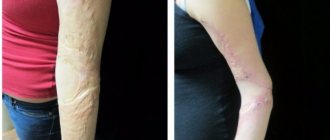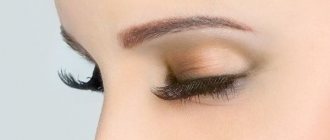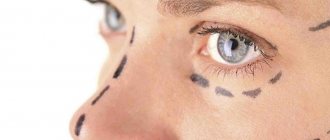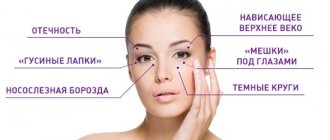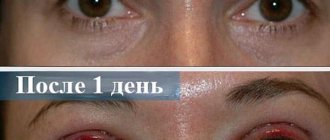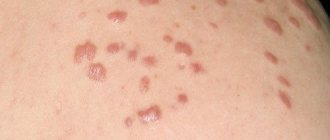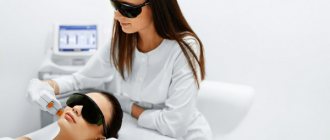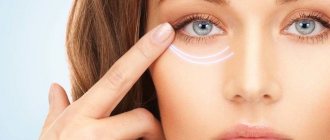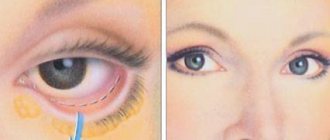If you want to improve your appearance or are experiencing functional problems with your eyelids, then eyelid surgery can help rejuvenate the area around the eyes and remove loose, sagging skin.
For blepharoplasty, as for any other operation, incisions are made in the skin of the eyelids (or conjunctiva), which are then sutured. In order for the skin or mucous membrane around the incisions to recover faster without scars or marks, proper care of the sutures is required during the rehabilitation period. A patient and careful attitude towards sutures is also important in order not to spoil the work done by the surgeon and to get the maximum possible effect from the aesthetic surgery.
How are scars formed?
When deciding on any type of blepharoplasty, remember that after making incisions in the epithelium, traces always remain. This is explained by the fact that no matter what the operation, after surgical manipulations there are always stitches and scar tissue is formed. But what the scar will look like after lower blepharoplasty depends on a number of factors:
- correct implementation of the plastic surgeon’s recommendations regarding skin care;
- features of human physiology;
- skill of the plastic surgeon who performed the plastic surgery.
Usually, after blepharoplasty, small scars remain in the form of a thin light strip located in the fold of the eye epithelium. Thanks to the use of modern techniques and discreet incisions, scars become less noticeable to the unprofessional eye.
Scars become a patient's problem only in case of improper care or non-compliance with medical recommendations. Then small traces from operations can lead to an increase in connective tissue and the formation of colloidal scars.
We invite you to see photos of scars after blepharoplasty
Alternative
There are times when incisions are not necessary for eye rejuvenation. When the eyebrows droop, causing excess skin of the upper eyelids to sag, classic blepharoplasty can emphasize the drooping, making the eye contour sharper.
An alternative to it are brow lifting techniques: endoscopic, mini-access lifting, as well as coronary lifting techniques, which allow you to achieve an open look, eliminate overhanging skin of the upper eyelid and change the shape of the eyebrow without making incisions on the eyelids.
With these techniques, incisions are made in the temporal and frontal areas of the head, and with coronary lifting, a bicoronal incision is made from one ear to the other. The operations vary in degree of trauma, but the sutures are always located in the hair growth area and remain invisible to others.
When deciding to undergo eyelid correction surgery, it is worth considering the recommendations and rules of care. The choice of a highly qualified specialist and an appropriate medical institution is of paramount importance.
Doctors' recommendations for preventing scars
An important rule that helps eliminate unwanted consequences after surgery is to follow the recommendations of the plastic surgeon during the rehabilitation period:
- In the first week after surgery, you should stop reading your favorite books, magazines, and watching television programs;
- do not stretch or rub the epithelium next to the marks from the operation;
- try to avoid exposure to ultraviolet rays on your face as much as possible, wear glasses for protection;
- do not visit solariums, saunas and steam baths (at least 2 weeks after surgery);
- reduce the level of physical activity on the body;
- When taking a bath, try to use warm (preferably cool) water; the seams should not be wet;
- Minimize salt intake to avoid swelling.
The doctor will also tell you about the care products that need to be used during the rehabilitation period.
How long will it take for scars to heal?
After blepharoplasty, the patient is usually sent home after 3-5 hours. This is allowed only if there are no complications. The next day after surgery, pain, swelling, bruises and redness in the eye area may appear. Such symptoms are normal and occur due to damage to nerves and blood vessels. To eliminate discomfort, it is recommended to apply cold compresses to the affected areas.
Removal of postoperative sutures is performed on days 5-6, but swelling and bruising may remain for another two weeks. Keloid scars after blepharoplasty take a long time to heal. This happens in several phases:
- Exudative stage. Its duration is 6-8 days. This phase is considered inflammatory, since the eyelids remain red and swelling is observed. During this period, it is recommended to adhere to the rules of seam hygiene. Physical activity is not allowed, as it will lead to the sutures coming apart and causing bleeding. It is also important not to strain your eyes at this stage.
- Granulation of seams. This period is observed for the first 7-14 days after surgical procedures. At the site of the scar, new tissue appears, elastin and collagen fibers are formed. Scars are usually pink in color.
- Scar formation. Scars appear 30-90 days after eyelid surgery. The seam structure becomes more dense. The scar tissue is lightened and smoothed out. This stage is the most important, since if all rehabilitation rules are not followed, hypertrophic or keloid scars will occur.
- The scar fully matures 4-9 months after eyelid surgery. The scar thickens, turns white, evens out, and becomes invisible.
If all medical recommendations are followed, scar healing occurs painlessly for the patient and unnoticed by others.
The location of the scars depends on the type of lift. After plastic surgery of the lower eyelids, they are formed along the visual organ under the ciliary edge. With complete regeneration, they are no different from the structure of normal epithelium. The transconjunctival technique allows you to hide scars, since the incisions are made from the inside. With upper eyelid surgery, the scars are located in the crease above the eyes; they become invisible 14 days after the operation.
You can learn more about scars after blepharoplasty from the video:
Possible complications
If you strictly follow the doctor’s recommendations and do not self-medicate, then there should be no complications. Naturally, the possibility of developing a complication is influenced by the qualifications of the surgeon. But the rehabilitation process depends on the patient.
What not to do with stitches after blepharoplasty:
- Do not touch the seams. Touching, rubbing, stretching, massaging incision areas - all this is strictly prohibited. This will lead to infection and inflammation of the wound;
- apply heat, take hot baths, go to the sauna or bathhouse. Heat has an extremely negative effect on the healing process. After visiting a bathhouse or sauna, even after taking a hot bath, the suture may turn red due to the rush of blood and the entry of red blood cells into the granulation tissue;
- You cannot be in the sun without sunglasses. Ultraviolet radiation negatively affects the healing process;
- Moderate physical activity should be avoided for 1 to 5 weeks after surgery. Heavy loads – for 1-4 months.
The seams may move. The condition of the patient's skin plays a big role in choosing the surgical technique and the subsequent recovery period. For example, if a patient has weakness in the lower eyelid, the suture after blepharoplasty may move downwards under the influence of gravity.
This phenomenon is observed in patients with a full face and large cheeks - the sutures pull back the skin of the eyelid. When performing upper blepharoplasty, the scar extends beyond the natural fold.
With lower blepharoplasty, the scar blends downwards, forming an eversion of the lower eyelid. When excision of a huge amount of skin, a problem may arise - the suture does not heal.
After blepharoplasty with the removal of too much skin from the eyelids, the wound will constantly diverge as tissue tension pulls the edges in opposite directions. Therefore, it is important to wear the patch for a couple of days after surgery until the stitches are removed.
It is also important to contact an experienced surgeon who will perform the operation correctly, including marking the incisions. Marking should not be done on a patient who is in a supine position, as the surgeon will not be able to properly see the excess skin. Marking of incisions is performed only in a sitting or standing position.
How to smear scars after blepharoplasty
To avoid overgrowth of connective tissues and to form smooth skin at the scar site, it is recommended to use special silicone-based ointments for scars after blepharoplasty.
Let's consider the most popular means and the principle of their action.
| Name of the drug | Operating principle |
| Dermatix Gel | The ointment is based on silicone, helps soften connective tissues, preventing the formation of uneven, rough scars. Perfectly regulates the water balance of the epithelium. |
| Contractubex | The cream base is allontoin. This is a substance that helps in healing and restoration of damaged tissue. The gel helps soften and moisturize connective tissue and eliminate discomfort. |
| Kelofibrase | The gel, based on components of natural origin, has an anti-inflammatory and moisturizing effect. Helps improve blood circulation in the dermis, normalizes water balance, and this helps in eliminating scar tissue. |
| Scarguard | Liquid structure composition containing silicone. Apply with a special brush. After drying on the eyelids, the drug creates a film layer that retains moisture, which will be needed to soften the scars. |
| Clearvin | Ointment based on herbal ingredients. It contains extracts of medicinal cultures. The product helps in restoration, nutrition, and improvement of blood circulation in the epithelium. |
| Zeraderm | Has a silicone base. Perfectly saturates the epithelium with oxygen, fills it with vitamins, and guarantees rapid recovery. |
| Sledotsid | Excellently relieves inflammation and guarantees tissue regeneration. To achieve the desired result, the composition is applied at least 2 times a day. |
Dermatix bandage
Silicone dressings are available in clear and fabric bases. The first option allows repeated use over a period of five weeks. This type is very convenient when used on exposed skin. You can use the option with a fabric base for six weeks. This type of silicone bandage is comfortable to wear under clothing.
Often, in a rush to save money, people want to find cheap analogues of Dermatix. Unfortunately, there are no gels and dressings with an absolutely identical composition and effect of therapy on the pharmacological market. Purchasing similar medications may result in wasteful spending.
Using a bandage also requires cleaning the skin. Application is only permissible on dry areas. The protective layer from the dressing must be saved for subsequent uses. Apply it in a sticky layer to injured skin. You need to walk with the Dermatix bandage 12 hours a day. Before each reuse, wash and dry the bandage.
Reviews and photos of scars
Silicone-based gels have been used for treating scars for many years. European dermatologists, when choosing between Dermatix or Contractubex, prefer to prescribe the first option to their patients.
The most popular questions about the drug Dermatix: price, reviews and analogues. The cost may vary and starts from 2000 rubles for a gel and from 1500 for a bandage. You can find different reviews about Dermatix, but on reliable resources positive ones always prevail.
Impact results
The objectivity of assessing the effectiveness of Dermatix treatment is most obvious in the photo. Patients confirm that as a result of exposure, the skin layers are leveled, compactions dissolve, and the transition of skin tone becomes less noticeable. The best way to see the difference is in the Dermatix before and after photo. They allow you to track transformations during application and upon completion.
The use of gels and dressings does not guarantee complete and absolute elimination of scars and scars. Skin healing is a complex process involving many factors. At the same time, experience of use and clinical trials have shown that the use of Contrubex makes scars invisible and elastic.
Treatment of scars after blepharoplasty
There are many ways to treat scars caused by blepharoplasty. Let's look at the most popular:
- Laser resurfacing of scars after blepharoplasty. The process of tissue resurfacing after eyelid surgery is carried out using innovative erbium lasers. To completely eliminate scars, you will need from 5 to 7 sessions. After the procedures there is no need for rehabilitation, there are no unpleasant sensations during the session, and the risk of burns is zero.
- Excision of scar tissue. This method is used only in extreme cases, when the scars are too large and very noticeable. Thanks to excision, it will be possible to completely get rid of scars. You should consult your doctor about the possibility of scar excision.
- Use of cryotherapy. This method is based on the use of liquid nitrogen at minimally low temperatures. The technique allows you to lighten the scar and make it thin.
Before deciding to use one or another method of treating scars, it is recommended to first consult with your doctor.
In the photo, a keloid scar is being polished after blepharoplasty:
Injection methods for treating scars
Medicinal injections are one of the most effective methods for eliminating scars. The most popular methods:
- Use of corticosteroids. The substances help reduce the proliferation of connective tissues because they reduce collagen synthesis. The most popular steroid is triamcinolone acetate. It is injected into the scar site after 4-6 weeks. Complications such as muscle atrophy and pigmentation are possible.
- Immunomodulators. A relatively new technique. Interferon is injected into the scar tissue. The procedure is prescribed in sessions every other day for 14 days. After completing this course, 1 injection is given once every 7 days.
- Treatment of scars with blepharoplasty with Botox. The use of botulinum toxin injections helps reduce postoperative scars and makes them thinner.
To achieve the desired result, you need to contact experienced specialists who have encountered similar problems.
Removing stitches
On what day are stitches removed?
Sutures are removed 3–7 days after surgery. A patch is applied in their place for 3 days, and after 4 days everything is removed. The skin then heals on its own and is treated with special ointments or gels to speed up the healing of the sutures.
If the surgeon used self-absorbing sutures, they will not need to be removed. Such threads disappear on their own.
Is it painful to remove stitches after blepharoplasty?
According to patient reviews, the removal procedure is tolerable. If the person wishes, the area will be lubricated with an anesthetic before the threads are removed.
You cannot remove it yourself, pull out the stitches or massage the eyelids before removal.
After the threads are removed, scars form. The skin will be sensitive for approximately 7 days after removal. Soreness is a normal reaction of the body to the removal of a foreign object.
If necessary, the doctor will prescribe painkillers if the pain is unbearable.
Usually, suture removal is painless. Only some time after the procedure may the skin in the injured area be slightly pulled.
How to remove scars after blepharoplasty using traditional methods?
If after blepharoplasty there are long scars, and you are not ready for radical methods, you can use the traditional methods presented in the table:
| Product name | Cooking method |
| Herbal collection | Take dry chamomile, nettle leaves, yarrow, calendula, St. John's wort in equal parts. Pour water (250 ml of boiling water) over the herbs and leave in a heat bath for 65 minutes. After this, the composition is filtered. A piece of linen cloth is soaked in the prepared preparation and applied to the scars. The lotion is kept for 2 hours. |
| Wax-olive mixture | Olive oil (220 ml) is poured into a pan, 50 g of high-quality beeswax is added. The mixture is placed on low heat for 10-12 minutes. After this, the composition is cooled, a linen or cotton napkin is soaked in it, and applied to the scars. The procedure is carried out at least twice a day for 60 days. |
| Parsley tincture | Chop the parsley and pour boiling water (1 cup). The product is left for 15 minutes, then the composition is frozen, divided into small portions. Ice cubes are used to wipe the scar twice a day. Duration of therapy is 3 months. |
| Marshmallow tincture | Finely chop 15 g of marshmallow root, add 250 ml of cold water and leave for 5-7 hours. After the specified time, use the infusion to treat scars every 3-4 hours. In the absence of marshmallow, it is replaced with mint or lemon balm. |
| Melon mask | Take 12-20 melon seeds, 2 eggshells, 5 ml of olive oil. The seeds are dried, crushed, then all components are mixed. The prepared mask is applied to the scar and wrapped with a bandage. The course of treatment is 1 month. |
It is recommended to use traditional medicine only after consulting a doctor. They do not guarantee a quick result, but after a course of treatment they can reduce the appearance of scars.
Reviews from patients about the treatment of scars after blepharoplasty
Review 1, Elena, 34 years old, Moscow:
“After blepharoplasty there were terrible scars. At first I used Contractubex, but it didn’t help me much. The specialist who performed my operation advised me to try laser resurfacing. I've only had 5 sessions and the results are already amazing. If you also have the same problem, don’t be afraid - get laser resurfacing and your appearance will only get better.”
Review 2, Margarita, 45 years old, Murmansk:
“I had blepharoplasty with one of the best surgeons in the city, but the scars still remained. I tried all sorts of ointments, even folk remedies, but the scars were noticeable. On the Internet I came across injection techniques - the administration of corticosteroids. Having received the doctor’s approval, I signed up for manipulation. The process is long and the results are not immediately visible. But after a month, the scars became less noticeable. The technique really works. I recommend!"
Principle of procedure
A laser machine is a station that creates light. A laser beam is a beam of light that consists of precisely ordered waves, precisely aimed parallel to each other. It is this orderliness that allows the resulting beam to be used in medicine and cosmetology.
We recommend: How long does upper eyelid blepharoplasty take to heal?
Each of their chromophores absorbs laser action of its own wavelength and becomes a target during cosmetic laser treatment of the skin. Adjustable wavelength and frequency allow the cosmetologist to selectively influence the structure of the scar without harming other components of the skin.
